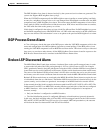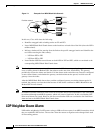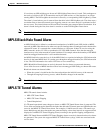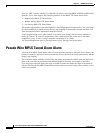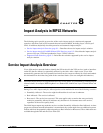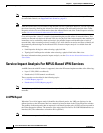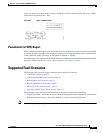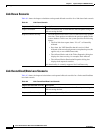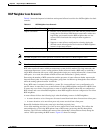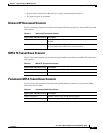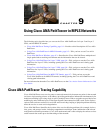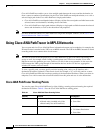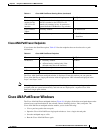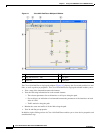
8-5
Cisco Active Network Abstraction 3.6.6 MPLS User Guide
OL-19192-01
Chapter 8 Impact Analysis in MPLS Networks
Supported Fault Scenarios
BGP Neighbor Loss Scenario
Table 8-3 shows the impacted calculations and reported affected severities for a BGP neighbor loss fault
scenario.
Note The BGP Neighbor Loss alarm represents a scenario where there is a BGP neighbor down.
Note The affected only relate to L3 VPN services.
BGP rules require all routers within an autonomous system be fully meshed. For large networks, this
requirement represents a severe scaling problem. Route reflectors enable a BGP entity to establish a
single BGP connection with a peer, where through that single peer, routing information is learned from
other peers. As a result, the number of BGP sessions and connections is greatly reduced.
Decreasing the number of BGP connections and the presence of route reflectors further separates the
data and control paths. For example, data packets going from A to B do not go through the route reflector
while the routing updates between A and B do.
Every BGP router is uniquely identified by a router ID. A route reflector is not a configuration of a
specific router. A router may act as a route reflector if it has a BGP neighbor configured as a BGP client.
A router may act as both a route reflector to some of its BGP neighbors (those that are configured as
BGP clients) and a non-client BGP neighbor to those BGP neighbors that are configured as non-client
BGP neighbors.
A route reflector follows the following logic when distributing routes to its BGP neighbors:
• A router advertises to its client peers all routes learned from both other client and non-client peers.
• A router advertises to its non-client peers only routes received from client peers.
Router ID distribution follows the same logic described previously here.
Cisco ANA modeling provides a list of one or more router IDs for each interface. This reflects the
network behavior of receiving BGP updates from a BGP router (possessing that ID) through that
interface. The VNE also maintains the nature of the relationships (client and non-client) among the
various VNEs representing the BGP routers. Figure 8-2 shows an example.
Table 8-3 BGP Neighbor Loss Scenario
Impact and Affected Severity Description
Impact calculation
• Initiates a local affected flow to all VRFs that are present on the
issuing device. Each local VRF that has route entries with a next
hop IP that was learned from the BGP neighbor that was lost
collects VRFs from both sides and pairs them together as
affected.
• Supports a route reflector configuration, whereby during the
affected search, affected parties are located on all BGP neighbors
learned via the route reflector.
Reported affected severity Only reports on Real Affected on the IBGP domain.



